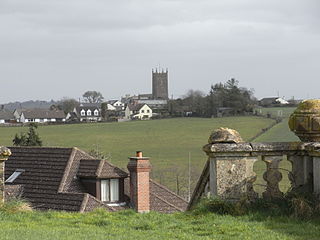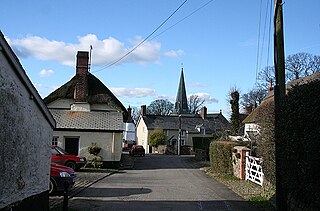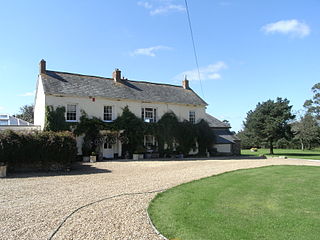
Tamerton Foliot is a village situated in the north of Plymouth, England, that also lends its name to the ecclesiastical parish of the same name.

St Giles in the Wood is a village and civil parish in the Torridge district of Devon, England. The village lies about 2.5 miles east of the town of Great Torrington, and the parish, which had a population of 566 in 2001 compared with 623 in 1901, is surrounded clockwise from the north by the parishes of Huntshaw, Yarnscombe, High Bickington, Roborough, Beaford, Little Torrington and Great Torrington. Most of the Victorian terraced cottages in the village, on the east side of the church, were built by the Rolle Estate.
Bowden is a historic estate in the parish of Yealmpton in Devon, England. From the 15th century until 1748 the manor house was for eight generations the seat of a junior branch of the Copleston family of Copplestone. The manor house was largely rebuilt in the 19th century and, together with some of its outbuildings, now serves as a farmhouse.

King's Nympton is a village, parish and former manor in North Devon, England in the heart of the rolling countryside between Exmoor and Dartmoor, some 4½ miles (7 km) S.S.W. of South Molton and 4 miles (6 km) N. of Chulmleigh. The parish exceeds 5,500 acres (2,226 ha) in area and sits mostly on a promontory above the River Mole which forms nearly half of its parish boundary.

Sir Hugh Pollard lord of the manor of King's Nympton in Devon, was Sheriff of Devon in 1535/6 and in 1545 was appointed Recorder of Barnstaple in Devon.

Sir Hugh Pollard, 2nd Baronet was an English soldier and MP elected for Bere Alston in 1640, Callington in 1660, and Devon in 1661. He supported the Royalist cause in the English Civil War.

Sir Lewis Pollard of Grilstone in the parish of Bishop's Nympton, Devon, was Justice of the Common Pleas from 1514 to 1526 and served as MP for Totnes in 1491 and was a JP in Devon in 1492. He was knighted after 1509. He was one of several Devonshire men to be "innated with a genius to study law", as identified by Fuller, who became eminent lawyers at a national level. He was a kinsman of the judge and Speaker of the House of Commons Sir John Pollard.

Sir Amyas Pollard, 3rd Baronet (1616–1701) was an English gentleman of Devon and a baronet. Little is known of his life except that he was a staunch royalist during the Civil War, as evidenced by the inscribed verse on his ledger stone at Abbots Bickington: Who durst the King & royall cause still own, In times when doing it was so dangerous known. He was the last in the male line of the ancient Pollard family of Bishop's Nympton. He inherited the baronetcy from his elder brother Sir Hugh Pollard, 2nd Baronet (1603–1666) who left the Pollard estates much reduced and encumbered with debts. He was forced soon after his inheritance to sell the manor of Bishop's Nympton and moved to Abbots Bickington, a smaller family manor, and made his seat at Court Barton, immediately to the south of the small parish church.

The Manor of King's Nympton was a manor largely co-terminous with the parish of King's Nympton in Devon, England.

Nutwell in the parish of Woodbury on the south coast of Devon is a historic manor and the site of a Georgian neo-classical Grade II* listed mansion house known as Nutwell Court. The house is situated on the east bank of the estuary of the River Exe, on low-lying ground nearly contiguous to the water, and almost facing Powderham Castle similarly sited on the west bank. The manor was long held by the powerful Dynham family, which also held adjacent Lympstone, and was according to Risdon the site of their castle until John Dynham, 1st Baron Dynham (1433–1501), the last in the male line, converted it into "a fair and stately dwelling house".

Way is a historic estate in the parish of St Giles in the Wood, Devon. It is situated about 2 miles (3.2 km) north-east of the village of St Giles in the Wood and about 4 miles (6.4 km) north-east of the town of Great Torrington. It was described by Hoskins (1959) as "the fons et origo of the mighty tribe of Pollard" and had been acquired by them from the de la Way family at some time before 1242.

Langley was a historic estate in the parish of Yarnscombe, Devon, situated one mile north-east of the village of Yarnscombe. It was long the seat of a junior branch of the Pollard family of Way in the parish of St Giles in the Wood, Devon, 3 miles to the south.

Warleigh is an historic estate within the parish of Bickleigh in Devon, about 6 miles from Plymouth. Warleigh House, the manor house of the manor of Tamerton Foliot is situated one mile west of that village on the south-east bank of the River Tavy where it joins the River Tamar. It was remodelled in about 1830 in the Gothic style by John Foulston and has been listed Grade II* on the National Heritage List for England since 1960.

The Manor of Ashton was a historic manor in Devonshire, England, of which the manor house was called Ashton House, in the parish of Ashton, situated about 6 miles south-west of Exeter, on the western slopes of the Haldon Hills. It was long the seat of the Chudleigh family, from about 1320 to 1745, which originated at the manor of Chudleigh, 3 miles south of Ashton, and for which was created the Chudleigh baronetcy in 1622. It was abandoned by Sir George Chudleigh, 4th Baronet who in 1735 built himself nearby a grand mansion named Haldon House, on the east side of the Haldon Hills, influenced by Buckingham House in London, and moved his residence there.

The large parish church of St Giles, which is in the village of St Giles in the Wood, Devon, England, came into being in 1309. When it was restored in 1862–3, many monuments were retained, including the monument and effigy of Thomas Chafe of Dodscott, three monumental brasses, of Alenora Pollard, Margaret Rolle of Stevenstone and a small brass of her husband John Rolle (d.1570). There are also 19th- and 20th-century monuments to the Rolle family.

Columb John in the parish of Broadclyst in Devon, England, is an historic estate and was briefly the seat of the prominent Acland family which later moved to the adjacent estate of Killerton. Nothing of the structure of the Acland mansion house survives except the arch to the gatehouse, dated about 1590, and the private chapel, restored in 1851. The site of the former mansion house is situated one mile due west of Killerton House, and five miles north-east of the historic centre of the City of Exeter. The estate's name derives from it having been held by the Culme family, whose own name was taken from its landholdings in the vicinity of the River Culm, which flows through the Columb John estate.

Sir Hugh Stucley (1496–1559) was the lord of Affeton in Devon, and Sheriff of Devon in 1545. His third son was Thomas Stukley, known as "The Lusty Stucley".

Lyneham in the parish of Yealmpton in Devon, is an historic estate. The surviving grand mansion house known as Lyneham House is a grade I listed building. It was built c.1699-1703 by Sir Courtenay Croker, MP for Plympton Morice in 1699. A drawing of Lyneham House dated 1716 by Edmund Prideaux (1693–1745) of Prideaux Place, Padstow, Cornwall, survives at Prideaux Place. It shows formal gardens in front with flanking pavilions and an orangery.

Grilstone in the parish of Bishop's Nympton in north Devon, England, is an historic estate. The present grade II listed house, situated about 1 1/4 miles south-east of the market town of South Molton, is Georgian, an 1834 extension and remodelling by Rev. William Thorne of an earlier building.
The manor of Alverdiscott was a manor situated in north Devon, England, which included the village of Alverdiscott.
















